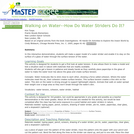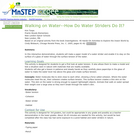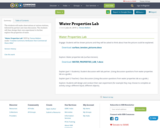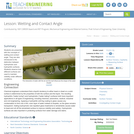
Surface tension in water, and how the surface tension is related to hydrogen bonding.
- Subject:
- Biology
- Life Science
- Material Type:
- Lesson
- Provider:
- Khan Academy
- Provider Set:
- Khan Academy
- Author:
- Sal Khan
- Date Added:
- 07/02/2015

Surface tension in water, and how the surface tension is related to hydrogen bonding.

Students learn about the basics of molecules and how they interact with each other. They learn about the idea of polar and non-polar molecules and how they act with other fluids and surfaces. Students acquire a conceptual understanding of surfactant molecules and how they work on a molecular level. They also learn of the importance of surfactants, such as soaps, and their use in everyday life. Through associated activities, students explore how surfactant molecules are able to bring together two substances that typically do not mix, such as oil and water. This lesson and its associated activities are easily scalable for grades 3-12.

Students see how different levels of surface tension affect water's ability to move. Teams "race" water droplets down tracks made of different materials, making measurements, collecting data, making calculations, graphing results and comparing to their predictions and the properties of each surface, determining which surface exhibits the highest (or lowest) level of surface tension with water. They apply their results to make engineering recommendations for real-world applications.

In this experiment, students create a "lava lamp" - a beaker on a hotplate, and investigate buoyancy, convection and other fluid and thermodynamic properties using ink, water, vegetable oil and Alka-Seltzer tablets. The activity is from PUMAS - Practical Uses of Math and Science - a collection of brief examples created by scientists and engineers showing how math and science topics taught in K-12 classes have real world applications.

This activity provides students with a first look at water tension and its role in the life of a water strider.

This activity provides students with a first look at water tension and its role in the life of a water strider.

The students will make observations at various stations, followed by partner and class discussion. The students will then design their own experiment to further explore the properties of water.

Students conduct a simple test to determine how many drops of each of three liquids water, rubbing alcohol, vegetable oil can be placed on a penny before spilling over. Because of their different surface tensions, more water can be piled on top of a penny than either of the other two liquids. However, the main point of the activity is for students to come up with an explanation for their observations about the different amounts of liquids a penny can hold. To do this, they create hypotheses that explain their observations, and because middle school students are not likely to have prior knowledge of the property of surface tension, their hypotheses are not likely to include this idea. Then they are asked to come up with ways to test their hypotheses, although they do not need to actually conduct these tests as part of this activity.

Students are presented with the concepts of wetting and contact angle. They are also introduced to the distinction between hydrophobic and hydrophilic surfaces. Students observe how different surfaces are used to maintain visibility under different conditions.